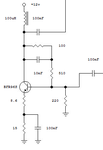neazoi
Advanced Member level 6

Hello, I would like to build a LPF for 30MHz cut-off using LC.
Power input will be something like 1W or so.
Output impedance must be 50R.
The input will be fed from an amplifier that has a choke in series with the PSU to the BJT collector, and a 100nF capacitor from the collector to the output. I do not know the impedance of such a thing. If I knew that I could try something with the RFsim99.
I would like some help or any schematics/simulations if possible.
Power input will be something like 1W or so.
Output impedance must be 50R.
The input will be fed from an amplifier that has a choke in series with the PSU to the BJT collector, and a 100nF capacitor from the collector to the output. I do not know the impedance of such a thing. If I knew that I could try something with the RFsim99.
I would like some help or any schematics/simulations if possible.








